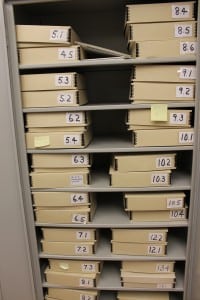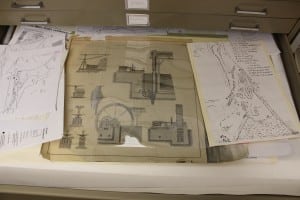Volunteers Corinne Giunta and Lillian McGuinness help find the answers to inquiries
By Alison Rooney
The questions just keep coming in. On any given Wednesday, the day the Putnam History Museum (PHM) designates for research, information might be sought on the birth date of an ancestor, the century-old boundary of a property or a particular aspect of manufacturing related to the West Point Foundry. The questions arrive from individuals living locally and also from people around the world, each seeking some elusive confirmation of information related to this side of Putnam County (requests relating to the eastern side are directed to the office of the Putnam County historian in Brewster).
PHM research librarian volunteers Corinne Giunta and Lillian McGuinness handle quite a few of them. They, along with Janet Rust and a few other history buffs, have come to know the museum’s archived collections quite well, and, with a carefully catalogued, still largely non-digitalized system, are able to ferret through volumes, papers, maps and boxes of individual documents to assist those seeking the information.

Neither McGuinness nor Giunta grew up in the area (though Rust did — and can handily advise on points such as “there was no store there — she’s very accurate, we rely on her quite a bit,” said Giunta), and part of what drew them here was the all-encompassing, rich sense of history that permeates this region. McGuinness, who has been doing this research for almost 20 years, called history “a wonderful, living thing.”
Giunta, a Philipstown resident for only eight years, was looking for a volunteer opportunity when she moved to the area, and, having done her own family tree, was familiar with that type of research and thought this would be interesting. Her dedication earned her the PHM’s Elizabeth Todd Healy Volunteer Service Award, which she was honored with last November.
Working from stacks of printed emails, as well as assisting with “walk-in” enquiries, Giunta and McGuinness tackle questions relating to prominent families with long-standing roots in Philipstown, including such familiar names as Kemble and Davenport. They frequently get requests for the location of particular graves in one of the many local cemeteries.

Another regular topic concerns the lineage of a particular home in the area; people are interested in the personal history of their homes. Giunta said it can be as vague as “I always pass this large mansion up on a hill … can you tell me what it is?” Particulars about houses are sought, too: “We have surveys, where we can find the size, even the original finish on the house — anything within the boundaries of the historic district,” noted McGuinness.
Much has to do with satisfying the stipulations of the Historic District Review Board, with investigations into original windows and roofs; photographic proof of the original designs is always sought after.
It’s not just curious locals and homeowners seeking details; it’s academics and other researchers, and young students, too. “Sometimes if someone is writing a local or regional history book, they’ll fact-check with us — and hopefully donate a copy of their work once it is published,” Giunta noted.
Those donations vie for space with boxes of photo collections, books (two shelves hold first editions of all the works of Susan and Anna Warner, also known as the Warner Sisters, of Constitution Island), donated family bibles and a bible of a different kind, a volume called The History of Putnam County, by William Pelletreau, published in 1886. The museum currently has three copies of it, all dog-eared from frequent use. There are clippings from local newspapers dating back to the 1860s, and full newspapers viewable on microfilm machines that are now almost as archaic as their searchable content.

Although a complete digitalization of the collection is inevitable, right now the PHM is limited, economically, to keeping the collection “as is;” yet both Giunta and McGuinness said that physically keeping all of the material in optimal archival shape, i.e., preserved in a manner that will impede deterioration, is a priority and a necessity. Even if everything does, ultimately, become digitalized, both women feel there will still be a desire to come in and view actual documents, particularly maps and original photographs.
Knowing that the present will soon enough become the past, current materials are archived, with important civic stories from local papers, this one included, clipped, card-catalogue-indexed and stored in one of the numbered boxes that fill several large file-cabinet units. One such current topic is the Butterfield development.
An entire cabinet is devoted to the museum’s collection of papers devoted to the West Point Foundry. This includes original letters written by Robert Parrott, William Young and other figures. There are also many photographs, all curated with a directory available, as well as archaeological findings and reports done by Michigan Tech’s Elizabeth Norris and, earlier, by Ralph Brill.
Included in the collection are interesting snippets of foundry-related material, including a list of all the foundry workers and their occupations; two, chosen at random read “Basha Nelson, Millwright” and “Gouverneur Paulding, Owner,” and a House of Representatives post-war report listing all the ammunition purchased from the foundry, along with letters, account books, blueprints and more.
The Internet has “taken away a bit of our business,” McGuinness said, “in particular the genealogy sites, like Ancestry.com, where you can access true national records.” Still, much online information is “heresay, or just not exactly true, for instance the name Cold Spring — you still find it stated that it was named by George Washington, which probably isn’t true,” McGuinness said. “We have material here you will not find on the Internet.”

Giunta called it “idiosyncratic material, pieces of paper revealing small, historic details that won’t make it onto the Internet.”
A recent inquiry came from a professor in Scotland, whose last name is Haldane. He was researching the American branch of the family, and of course this led him to James Haldane, for whom Haldane School was named.
Anyone interested in researching at the museum itself, with the help of the research librarians, is welcomed between the hours of 11 a.m. and 4 p.m. each Wednesday. Appointments are encouraged, and there is a fee of $10 per hour. Copies can be made onsite. The PHS is located at 63 Chestnut St. in Cold Spring. For more information on research, phone 845-265-4010, ext. 17, or email [email protected]. Visit putnamhistorymuseum.org for information on the museum itself.
Photos by A. Rooney
